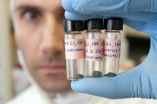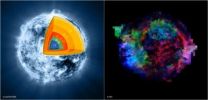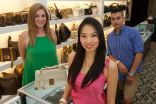(Press-News.org) A new chemical analysis of lunar material collected by Apollo astronauts in the 1970s conflicts with the widely held theory that a giant collision between Earth and a Mars-sized object gave birth to the moon 4.5 billion years ago.
In the giant-collision scenario, computer simulations suggest that the moon had two parents: Earth and a hypothetical planetary body that scientists call "Theia." But a comparative analysis of titanium from the moon, Earth and meteorites, published by Junjun Zhang, graduate student in geophysical sciences at the University of Chicago, and four co-authors indicates the moon's material came from Earth alone.
If two objects had given rise to the moon, "Just like in humans, the moon would have inherited some of the material from the Earth and some of the material from the impactor, approximately half and half," said Nicolas Dauphas, associate professor in geophysical sciences at UChicago, and co-author of the study, which appears in the March 25 edition of Nature Geoscience.
"What we found is that the child does not look any different compared to the Earth," Dauphas said. "It's a child with only one parent, as far as we can tell."
The research team based their analysis on titanium isotopes — forms of titanium that contain only slight subatomic variations. The researchers selected titanium for their study because the element is highly refractory. This means that titanium tends to remain in a solid or molten state rather than becoming a gas when exposed to tremendous heat. The resistance of titanium isotopes to vaporization makes it less likely that they would become incorporated by the Earth and the developing moon in equal amounts.
Titanium also contains different isotopic signatures forged in countless stellar explosions that occurred before the sun's birth. These explosions flung subtly different titanium isotopes into interstellar space. Different objects in the newly forming solar system gobbled up those isotopes in different ways through collisions, leaving clues that let scientists infer where the solar materials including the moon came from.
Planetary DNA
"When we look at different bodies, different asteroids, there are different isotopic signatures. It's like their different DNAs," Dauphas said. Meteorites, which are pieces of asteroids that have fallen to Earth, contain large variations in titanium isotopes. Measurements of terrestrial and lunar samples show that "the moon has a strictly identical isotopic composition to the Earth," he said.
"We thought that the moon had two parents, but when we look at the composition of the moon, it looks like it has only one parent," Zhang said.
Zhang initially found variations in the titanium isotopic composition between the lunar and terrestrial samples. She then corrected the results for the effects of cosmic rays, which could have changed the titanium isotopic composition of the lunar samples.
The Earth and the moon are constantly bombarded by cosmic rays from the sun and from more distant sources in the galaxy. Earth's atmosphere and magnetic field prevents most of these rays from reaching its surface, but the moon has no such protection.
"We compared the titanium isotopic composition with samarium and gadolinium since those two systems are very sensitive to the cosmic-ray effect," Zhang said. The only compositional differences the scientists expected to see in samarium and gandolinium between Earth and moon would be the result of cosmic rays. "We found a very nice linear correlation between titanium and samarium or gadolinium," she said.
Zhang's titanium analyses greatly reinforce previous work by other researchers who came to the same conclusion after comparing terrestrial and lunar oxygen isotopes, which are less refractory and thus more likely to gasify during a giant impact than titanium.
Lunar Conundrum
Solving the conundrum of the moon's origin probably will prove challenging because all of the alternative scenarios for the moon's formation have drawbacks.
For example, it is possible that even though titanium is refractory, it might still have gasified in the giant impact and then became incorporated into the disk of Earth-orbiting material that developed into the moon. This might have erased the signature of the titanium from Theia, which could explain the UChicago team's observations. The problem with this scenario is that the disk may have fallen back to Earth if too much material was exchanged between the two bodies.
An old idea, long abandoned, is that the moon arose via fission from a molten, rapidly rotating Earth following a giant impact. This idea explains the similarity between Earth and moon, but how such a large, concentrated mass could spin fast enough to split in two remains problematical.
According to a third scenario, Earth collided with an icy body lacking entirely in titanium. There are no bodies made purely of ice in the solar system, however. "They would always have a significant fraction
of solid material, so you would still expect the object to deliver some titanium," Dauphas said.
It's also possible that Theia had the same composition as Earth. This is unlikely, however, because of the widely accepted view that the Earth incorporated material over tens of millions of years in collisions with smaller bodies that flew in from different regions of the developing solar system.
"We thought we knew what the moon was made of and how it formed, but even 40 years after Apollo, there is still a lot of science to do with those samples that are in curatorial facilities at NASA," Dauphas said.
INFORMATION:
Citation: "The proto-Earth as a significant source of lunar material," by Junjun Zhang, Nicolas Dauphas, Andrew M. Davis, Ingo Leya, and Alexei Fedkin, Nature Geoscience, Advance Online Publication, March 25, 2012.
Funding: National Aeronautics and Space Administration, National Science Foundation, Packard Foundation and the Swiss National Science Foundation.
Titanium paternity test fingers Earth as moon's sole parent
2012-04-02
ELSE PRESS RELEASES FROM THIS DATE:
A star explodes and turns inside out
2012-04-02
A new X-ray study of the remains of an exploded star indicates that the supernova that disrupted the massive star may have turned it inside out in the process. Using very long observations of Cassiopeia A (or Cas A), a team of scientists has mapped the distribution elements in the supernova remnant in unprecedented detail. This information shows where the different layers of the pre-supernova star are located three hundred years after the explosion, and provides insight into the nature of the supernova.
An artist's illustration on the left shows a simplified picture ...
Global Provider PerDM Report Record Growth Due to Local Knowledge
2012-04-02
Last week PerDM reported growth of 16% in the first quarter of 2012, an increase of 6% from 2011. The Field Marketing Company's development has been attributed to their ability to provide successful marketing campaigns to businesses of all sizes. PerDM place importance on Nationwide or Global reach while ensuring that local consumer patterns and industry knowledge is obtained from individual markets. The concept of being able to offer and deliver maximum capacity and local expertise are difficult to master but essential to true optimisation.
'Out network of offices offer ...
LSUHSC research finds HPV-related head & neck cancers rising, highest in middle-aged white men
2012-04-02
New Orleans, LA – Research led by Lauren Cole, a public health graduate student, and Dr. Edward Peters, Associate Professor of Public Health and Director of the Epidemiology Program at LSU Health Sciences Center New Orleans, reports that the incidence of head and neck cancer has risen at sites associated with Human Papilloma Virus (HPV) infection, with the greatest increase among middle-aged white men. At the same time, younger, Non-Hispanic blacks experienced a substantial decrease in these cancers. They also found that the disease process for tumors associated with HPV ...
Dr Jill is a ProU Legacy2 Mastermind Graduate
2012-04-02
There were only 16 seats for this seminar that included over the shoulder work from some of the founders of ProU to jump start our businesses. There were many many more applicants to these seats than the event could hold and Dr Jill was lucky enough to get one of the seats. Dr Jill stated that it was a fast paced detailed, informative seminar. The one-on-one critique of the assignments that each participant brought with them was the best part of the weekend. Dr Jill now feels even more confident in her marketing endeavors with ProU. She is sure that she made the correct ...
Montana State study compares growth around Yellowstone, Glacier and other national parks
2012-04-02
BOZEMAN, Mont. – The land around Yellowstone and Glacier national parks might look like it's filling up with people and houses, but it's nothing compared to the rate of development around some other U.S. national parks, according to a new Montana State University study.
While population densities rose 246 percent around Yellowstone/Grand Teton and 210 percent around Glacier between 1940 and 2000, they surged 3,092 percent around the Mojave National Preserve in California, 2,962 percent around the Colorado River parks and almost 2,473 percent around the Everglades National ...
A new breast cancer susceptibility gene
2012-04-02
SALT LAKE CITY -- Mutations in a gene called XRCC2 cause increased breast cancer risk, according to a study published today in the American Journal of Human Genetics. The study looked at families that have a history of the disease but do not have mutations in the currently known breast cancer susceptibility genes.
Sean Tavtigian, Ph.D., a Huntsman Cancer Institute (HCI) investigator and associate professor in the Department of Oncological Sciences at the University of Utah (U of U) is one of three co-principal investigators on the study, along with David Goldgar, Ph.D., ...
Autism Speaks demands urgent response to the autism epidemic in new CDC prevalence estimates
2012-04-02
NEW YORK, N.Y. – Autism Speaks, the world's leading autism science and advocacy organization, today called on the nation's elected and appointed leaders to immediately develop a new, coordinated strategy to take on a national public health emergency – the autism epidemic – in the wake of a new report from the U.S. Centers for Disease Control (CDC) finding that autism is now diagnosed in a staggering 1 in every 88 American children.
Bob Wright, co-founder of Autism Speaks, said, "We have an epidemic on our hands. The costs are staggering and will continue to rise as prevalence ...
Designer Consignment Shop Appears on NBC 7 San Diego
2012-04-02
Authentic Luxury Goods (ALG), San Diego's designer consignment shop, has been featured in a recent special report by Consumer Bob on NBC 7 San Diego. Consumer Bob shows viewers "how they can make money selling their high-fashion accessories" by spotlighting the ALG boutique, which specializes in buying and selling lightly used designer handbags, shoes, jewelry, and watches.
Authentic Luxury Goods was founded last year by Joy Blackburn, who saw that San Diego women were longing for a special kind of consignment store, one that would deal exclusively in upscale ...
Breast cancer risk gene discovery fast tracked by new technology
2012-04-02
An international team of researchers led by the University of Melbourne has used new technology to fast track the discovery of a breast cancer risk gene and could assist in the discovery of other cancer genes.
Professor Melissa Southey of the Genetic Epidemiology Laboratory, Department of Pathology at the University of Melbourne, who led the study, said it was a significant discovery and the first breast cancer risk gene to be discovered using the latest genetic sequencing technology.
"The mutations in the newly identified gene XRCC2, although rare, explain another ...
Increasing water scarcity in California's Bay-Delta will necessitate trade-offs; 'hard decisions' needed to balance various environmental risks
2012-04-02
WASHINGTON — Simultaneously attaining a reliable water supply for California and protecting and rehabilitating its Bay-Delta ecosystem cannot be realized until better planning can identify how trade-offs between these two goals will be managed when water is limited, says a new report from the National Research Council. Recent efforts have been ineffective in meeting these goals because management is distributed among many agencies and organizations, which hinders development and implementation of an integrated, comprehensive plan. Additionally, it is impossible to restore ...




